Museu Nacional d'Art de Catalunya
 Museu Nacional d'Art de Catalunya | |
 Interactive fullscreen map | |
| Established | 1934 |
|---|---|
| Location | Palau Nacional, Barcelona |
| Coordinates | 41°22′6.0″N 2°9′11.9″E / 41.368333°N 2.153306°E |
| Type | Art museum |
| Collection size | 290,000 |
| Visitors | 828,713 (2010) |
| Director | Pepe Serra |
| Nearest car park | On site (no charge) |
| Website | museunacional.cat |


The Museu Nacional d'Art de Catalunya (Catalan pronunciation:
History
The history of this institution dates back to the 19th century, when, in accordance with the principles that inspired
The Palau Nacional, which has housed the Museu d'Art de Catalunya since 1934, was declared a national museum in 1990 under the Museums Law passed by the Catalan Government. In 1992 a thorough renovation process was launched to refurbish the site, based on plans drawn up by the architects Gae Aulenti and Enric Steegmann, who were later joined in the undertaking by Josep Benedito. The Oval Hall was reopened in 1992 on the occasion of the Olympic Games, and the various collections were installed and opened over the period from 1995 (when the Romanesque Art section was reopened) to 2004. The Museu Nacional d'Art de Catalunya (Museu Nacional) was officially inaugurated on 16 December 2004.
Since 2004, the Palau Nacional has once more housed several magnificent art collections, mostly by Catalan art, but also Spanish and European art. The works from that first museum have now been enriched by new purchases and donations, tracing the country's art history from early medieval times to the mid-20th century: from Romanesque, Gothic, Renaissance and baroque to modern art. This heritage is completed by the Gabinet Numismàtic de Catalunya (coin and medal collections), the Gabinet de Dibuixos i Gravats (drawings and engravings) and the library.[1]
Collections
Romanesque Art
With a series of important Romanesque
In the early 1920s many of the Pyrenean murals were moved to Barcelona as a consequence of the actions of an American art dealer in 1919. The art dealer purchased many of the frescos at the former monastery in
The Romanesque rooms are arranged in chronological and stylistic order, giving visitors a view of the different tendencies in Catalan Romanesque art and featuring works produced, for the most part, in the 11th, 12th and 13th centuries.
The visit to this section begins with the mural
However, the rooms of the Museu Nacional d'Art de Catalunya also feature a particularly outstanding example of European Romanesque art: the remarkable, original and extraordinarily expressive paintings from the
The Romanesque section ends with the
Romanesque rooms also show the techniques that distinguished Catalan art at the time, such as panel painting, wood carving and others that help to complete our aesthetic vision of Romanesque, such as precious metalwork and carving stone.
The collection of panel paintings, unique in Europe, is another singular aspect of Romanesque painting, due both to the number and antiquity of the Catalan works conserved (the result of interest in the Romanesque since the late19th century) and to their quality and technical diversity. Particularly outstanding are the frontals of the Apostles (also known as the
There are also sculptures in stone that form part of the Museu Nacional Romanesque art collection, particularly a number of works from Ripoll and a large group of elements from ensembles in the city of Barcelona, including the refined marble capitals from the former Hospital de Sant Nicolau. Finally, the Romanesque section also features an important collection of enamels, mostly produced in Limoges, such as the Mondoñedo Crosier.[7]
-
Altar frontal from Gia (from Benasque Valley, Aragon)
-
Paintings from Arlanza (from Castile and León)
-
Apse of la Seu d'Urgell
-
Apse of Santa Maria d'Àneu
-
Virgin of Ger
-
Mondoñedo Crosier (from Galicia)
Gothic Art Collection


The Museu Nacional d'Art de Catalunya Gothic art collection began to take shape in the early decades of the 19th century, when a movement was first launched to revive and conserve the important body of Catalan heritage, which had been seriously damaged in the wave of convent burnings that took place at around the time of the disentailment of church goods in the year 1835.
The Gothic collection features a considerable number of Catalan works accompanied, moreover, by an extraordinary selection of pieces from the other territories that were once ruled by the
The Gothic rooms display works from the late 13th, 14th and 15th centuries, arranged in chronological order, although the pieces are also grouped by school and typological affinity, and several thematic sections have been established. These include the renowned
Other works in this and the following rooms, from
Besides a few Italian examples, the Museu Nacional also features an important selection of Italian, Catalan and Aragonese painting, such as the
Amongst Catalan painters,
Besides this central strain in autochthonous painting, the panorama of Gothic art also features various other important episodes, such as the time spent by
-
Bartolomé Bermejo (Córdoban painter) – Resurrection and Descent of Christ into Limbo
-
Mural paintings of the Conquest of Majorca
-
The Consecration of Saint Augustine[9]
-
Gonçal Peris – Altarpiece of Saint Barbara (from Puertomingalvotown, Aragon)
Renaissance and Baroque Art Collection
The Museu Nacional d'Art de Catalunya Renaissance and baroque art collection comprises pieces of priceless cultural heritage that – unlike the collections at other great national museums in Europe, which were generally built up from royal and aristocratic collections – was established in Catalonia through the acquisition of local pieces and later complemented by donations and acquisitions from private galleries.
The itinerary begins with art from the
The 17th century begins with the
Entering now the 18th century, Antoni Viladomat's series of canvases devoted to the Life of St Francis, which decorated the main cloister of the former monastery of the Friars Minor in Barcelona, constitutes the only complete set of scenes from monastic life preserved in a museum. Finally, heralding the art forms that would develop in the 19th century, the daring works of Francesc Pla, known as El Vigatà, illustrate the painterly freedom taken when decorating the interiors of seigniorial mansions belonging to the new, wealthy classes who had made their fortunes in trade and industry.
The collection, which reflects the taste of certain sections of society for Renaissance and Baroque art, features (exceptionally, if compared to the rest of the Museu Nacional collections) art produced not only in Catalonia, but also in the rest of Spain, Italy and Flanders, providing an overview of the development of European art during this period. Two later donations made important contributions to this more general vision: the Cambó Bequest and the Thyssen-Bornemisza Collection.[10]
-
Martyrdom of Saint Bartholomew
-
Master of Frankfurt – Triptych of the Baptism of Christ
The Cambó Bequest
The collection of paintings that the Catalan politician and arts patron Francesc Cambó (1876–1947) built up with the intention of donating works by the great masters to complement the great medieval series in the Museu d'Art de Catalunya as it was then known, is the most valuable altruistic donation that the Museu Nacional has received in its history, and the one which has most served to enrich the body of Renaissance and Baroque works here.
The Cambó Bequest forms a collection of paintings embraces European painting history from the 14th to the early 20th century. It includes representative works of the Gothic and Renaissance periods, together with pieces that illustrate the perfection of the Italian
-
Tiziano Vecellio and workshop – Girl Before the Mirror
-
Giandomenico Tiepolo – The Charlatan
-
Jean-Claude Richard, abbé of Saint-Non
-
Francisco de Goya– Allegory of Love, Cupid and Psyche
Thyssen Bornemisza Collection
When the Thyssen-Bornemisza Collection was installed in the
The collection comprises paintings and sculptures spanning European art from the Gothic to the
Modern Art Collection
The Museu Nacional d'Art de Catalunya
The first part of this itinerary is devoted to the
-
Ramon Martí i Alsina – The Siesta
-
La Paloma
-
Josep Llimona – Desolation
The second movement richly represented in the Museu Nacional modern art collection is
The historic avant-garde is very well represented, particularly in terms of sculpture, with works including impressive sculptures by Pablo Gargallo, Julio González and Leandre Cristòfol, whilst in painting the most exceptional figure is Pablo Picasso, represented in the Museu Nacional d'Art de Catalunya collection since 2007.
Turning now to the field of photography, we should mention such avant-garde artists as Josep Masana, Josep Batlles, Pere Català Pic and Emili Godes, as well as Agustí Centelles for his important graphic work documenting the Spanish Civil War. Finally, the new avant-garde that emerged during the post-war years is represented by Otho Lloyd and Joaquim Gomis, whose pioneering work found its continuation in the Neorealists Francesc Català-Roca, Joan Colom, Oriol Maspons and Xavier Miserachs, among others.
The Carmen Thyssen Bornemisza Collection
In late 2004, to mark the opening of the Museu Nacional d'Art de Catalunya, the museum received a score of Catalan art works from the
The chronological period covered by this section spans from the mid-19th to the mid-20th century, one of the most brilliant moments in the history of Catalan art. Notable amongst the 19th-century pieces is Marià Fortuny's Bullfight, Wounded Picador, painted in 1867. As regards the Modernista movement, several of the most important artists from this period are represented, featuring
Cabinet of Drawings and Prints
The collections assembled from the museum's historic holdings to form the Museu Nacional d'Art de Catalunya Cabinet of Drawings and Prints comprise some 50,000 drawings, 70,000 engravings and more than 1,000 posters. The founds combine to offer a rich and wide-ranging journey through the most important movements in the history of Catalan art, particularly since the late 18th century, thanks largely to the establishment in Barcelona in 1775 of the Free School of Design and the Fine Arts. Popularly known as
However, there can be no doubt that one of the true highlights of these collections is the important body of works by Marià Fortuny, which include more than 1,500 drawings and 50 engravings, making the Cabinet of Drawings and Prints an essential reference for reconstructing the creative trajectory of this great 19th-century artist. From the same period, moreover, are more than 30 drawings by the history painter Eduardo Rosales, acquired in 1912, and linked to two of his finest and most characteristic historic compositions: The Testament of Queen Isabella the Catholic and the Death of Lucrecia.
The Modernista and noucentista movements are also widely represented in the Cabinet holdings. The collections include more than 600 Modernista posters by renowned Catalan and foreign artists. Among the most impressive are those by Ramon Casas, one of the most illustrious of all Modernista artists. Particularly mention should be made of the famous series of charcoal sketches, a veritable portrait gallery of the leading personalities of the era in Catalonia, and which Casas himself donated to the museum in 1909. Turning now to the noucentista movement, we should draw attention in particular to Isidre Nonell, represented in the Cabinet by some 150 pieces.
Nor should we forget the collection of posters from the same period, largely acquired by the museum from Lluís Plandiura in 1903. Comprising more than 500 pieces among which foreign artists are also well represented, this invaluable legacy constitutes an incomparable resource for tracing the history of poster art in Catalonia.
Finally, though the collection is rather uneven here, mention should be made of the printed works from the avant-garde movement. The sculptor
Two acquisitions made by the old Museums Board were fundamental to forming the collections contained in the Cabinet of Drawings and Prints. The first was the collection of literary and art critic Raimon Casellas, in 1911; the second, that of Modernista artist Alexandre de Riquer, ten years later.
Numismatic Cabinet of Catalonia
The collections of the Numismatic Cabinet of Catalonia, established in 1932, now comprises more than 134,000 pieces. This rich holding is the result of a long process of acquisition by purchase, donation, legacy or deposit, which began in the first half of the 19th century and continues even today.
The coin collection comprises nearly 100,000 pieces, including examples from the main series minted from the 6th century BC to the present. The most important and interesting amongst these are, without doubt, the coins produced in Catalonia, which include many extremely rare and unique pieces. The visit to the Numismatic Cabinet begins with the series of ancient coinage, outstanding among which are those minted on the
The medals collection is formed by more than 9,000 pieces, which range from the earliest, struck in Italy in the second half of the 15th century, to the present. The greater part of this collection is made up of works produced in Spain, mostly by well-known artists and engravers, who created medals of the highest quality. For example, the Museu Nacional medals collection features works by such outstanding 18th-century master engravers as Tomás Francisco Prieto and Gerónimo Antonio Gil. During the late 19th century, moreover, particularly after the 1888 Barcelona Exhibition, many Modernista sculptors turned to the art of medal-making, and the examples in the Cabinet fully reflect what was a splendid creative period for the genre, particularly in Catalonia. The leading artist in the field was, without doubt, Eusebi Arnau, but such sculptors as Parera, Blay, Llimona and Gargallo also created medals of the highest quality.
The central core of the MNC paper money collection, which embraces a wide range of documents of different types, is formed by its 4,100 examples of banknotes. These include the Spanish series containing all the banknotes issued by the Bank of Spain from 1874 to the present, as well as the series of paper money printed by the Catalan Government and local authorities in the country during the Spanish Civil War.
The Cabinet also exhibits a range of different pieces of interest due to their direct or indirect connection with numismatics. These include, amongst other things, tools used for minting coin, coin weights, scales, jettons (counters), pellofes and other types of tokens, stamps, medals and various documentary collections.
The building
The National Palau of Montjuïc, known as Palau Nacional was constructed between 1926 and 1929, with the goal of being the main building of the 1929 Barcelona International Exposition, holding an Exhibition of Spanish Art named El Arte en España (The Art of Spain). More than 5,000 works came to the Exhibition from across Spain.
The Palau Nacional is a huge building (over 50,000 square metres (540,000 sq ft)) which embodies the academic classical style that predominated in constructions for all the universal exhibitions of the period. Its façade is crowned by a great dome inspired by St. Peter's Basilica in the Vatican City in Rome, flanked by two smaller domes, while four towers modelled on Santiago de Compostela Cathedral stand at the corners of the so-called Sala Oval, or Oval Hall. This great space (2,300 m2), used as the venue for important civic and cultural events, is encircled by tiered seating, preceded by double columns; it also houses a monumental organ, one of the biggest in Europe, waiting for an important restoration work. Many of the most outstanding painters and sculptors of the day, for the most part followers of the Noucentista aesthetic and cultural movement, were commissioned to decorate the interior of the Palau. Entrance from the front is by a huge staircase leading up from Avinguda de la Reina Maria Cristina, flanked halfway by magnificent monumental illuminated fountains designed by Carles Buïgas.

The first projects to develop the slopes of Montjuïc, turning the mountain into the city's green lung and a leisure activity centre for the people of Barcelona, date back to the early 20th century. However, these ideas were given decisive momentum when Montjuïc was chosen as the site for the great International Exhibition organised by the city in 1929. The renowned Modernisme architect Josep Puig i Cadafalch was commissioned to direct the urban development and architectural aspects of this project, and Juan Claude Nicolas Forestier and Nicolau Maria Rubió i Tudurí landscaped the gardens. Under these plans, the Palau Nacional was to be the central palace for the exhibition. In 1923, the dictator Primo de Rivera seized power, with the result that Puig i Cadafalch was removed from the project. A competition to design and build the Palau Nacional was then won by the architects Eugenio P. Cendoya, Enric Catà and Pere Domènech i Roura. The palace was to provide the central venue for a great exhibition entitled Art in Spain and featuring original works and reproductions representing the history of Spanish art, complemented by two extensions: the Poble Espanyol (Spanish Village) architectural site, still open today, and the Palau d'Art Modern (Palace of Modern Art), which was later demolished.
In the area around the Museu Nacional d'Art de Catalunya site, moreover, many of the buildings erected for the 1929 International Exhibition remain, whilst others have also been established. All these different elements form a complex that has become one of the most attractive cultural, commercial and leisure centres in the city. The outstanding buildings dating from the time of the International Exhibition include the pavilions housing the Barcelona Trade Fair (
Library and archive
The library is the most important documentation centre open to the public. Its origins go back to the books referred to by museum technicians in Barcelona when preparing for the
The Museu Nacional Library collections comprise domestic and foreign books and magazines on different aspects of art: monographic works on art and artists; photography; numismatics; local history; a reserve section containing a collection of manuscripts; incunabula such as the 1493 Nuremberg Chronicle; works published pre 1900; and the books of artists and collector's editions. Sections of particular interest include that devoted to exhibition catalogues, established in 1913 and containing printed matter on shows held at galleries in Barcelona, Catalonia, Spain and even further afield, and 'The Press', established in 1968, which brings together news items published in the daily media and of interest to the artworld.
It is thanks to the Museu Nacional publications policy, that many of these works were acquired – it aims to promote exchanges and so provide the library with copies of works published by museums and art centres all over the world.
The library facilities are designed to provide Museu Nacional d'Art de Catalunya technical staff, researchers, students, art professionals and all individuals interested in the art world with all the information they seek. The reading room provides access to the library catalogue, the Collective Catalogue of Universities (CCUC), several databases (Princeton University, Index of Christian Art; Bibliography of the History of Art; Art Price), and to databases available on CD-ROM and Internet.
Another important element in the Museu Nacional organisational structure is the archive, founded as a department in 1995 to standardise management of the museum's documentary collections. With regard to the origin of these collections, the archive contains both documentation generated by the museum since 1991, when the consortium was set up, and historic documents from institutions that now form part of the Museu Nacional: the Museu d'Art de Catalunya (Art Museum of Catalonia), the Museu d'Art Modern (Museum of Modern Art), the Cabinet of Drawings and Prints, the Numismatic Cabinet of Catalonia, and the Library of Art History.
The archive also conserves invaluable historic documentation in the form of the collections built up by different organising committees for fine art exhibitions (1891–1946). Here, too, are other historic resources related to the world of art and deposited in the museum over the years.
Finally, the archive also contains a section devoted to the image, comprising some 350,000 audiovisual documents, mainly photographs, on different supports and in a variety of formats.[13]
Network of art museums
The Museu Nacional, as a museological institution of reference in the country, promotes a network that joins together the art museums in a common collaboration strategy, for placing value and spreading Catalan artistic heritage. The network of art museums was created with the aim of developing services, projects and activities jointly, so as to achieve a greater social, touristic and scientific projection among all the member museums. The following museums currently form part:
Educational activities

One of the other aspects of the Museu Nacional d'Art de Catalunya is the number of services and training proposals and entertainment for families and schools. The museum has an educational service itself, which offers several resources for learning and services tailored to different audiences. Among others, a program is the museum common space of integration aimed at people at risk of exclusion and use the museum as a key integrator and software Museum hosts, aimed at integrating with other training projects related to art.
Another of the best known proposals is Museum as an integration space (El Museu espai comú d'integració, in Catalan), and also A hand of stories (Una Ma de Contes), a joint initiative between Televisió de Catalunya and Museu Nacional, which explains 20 short stories representing 20 paintings of Museu Nacional permanent collection, with a different look.
There are also activities which are encouraged in the relationship between children and artists active. They participated in activities such contemporary artists as Philip Stanton Gino Rubert or Lluïsa Jover.[15]
Restoration and Preventive Conservation Centre

The aim of the Department of the Restoration and Preventive Conservation is to ensure the conservation of all the works in the Museu Nacional d'Art de Catalunya collections. The department helps to guarantee the physical conservation of all the museum's holdings, including both works on exhibition and in storage, on deposit or on loan, whilst also seeking to delay as far as possible the ageing process that affects the materials that form the artworks. In addition, the Restoration and Preventive Conservation Department also studies the materials and the technical aspects of works with a view to providing scientific and technical assistance for art historians specialising in different periods, promoting dialogue and interdisciplinary studies.
At the centre, professionals from different specialist disciplines study problems affecting the works, or changes they are undergoing, determining the causes of deterioration and doing their utmost to eliminate any risk to the works. In this regard, a key aim is to create a stable environment and to establish the best conditions for exhibiting, storing, handling, packing and transporting works. The centre seeks to minimise deterioration to the collections by ensuring that the most appropriate environmental conditions and exhibition systems are provided, as well as exercising strict control over the movement of objects and the restoration treatments applied to individual works.
Most of the activity at the centre is concerned with prevention, but due importance is also attached to reparative treatment and restoration. Restoration work is aimed at improving the aesthetic reading of pieces on which, very often, restorers from much earlier generations have previously intervened, working according to criteria very different from those applied today. Needless to say, restoration is not carried out in the hope of returning works to their original state; but rather, to take into account the passing of time and any work that has already been carried out on the piece, and which now forms part of the history of restoration in Catalonia in general.
The center exists due to the impulse that
The centre is staffed by scientific personnel devoted to preventive conservation and chemical laboratory work, and by a team of curators and restorers specialising in various disciplines, in accordance with the types of works that form the museum collections: restoration of paint on canvas and transferred painted murals; paint on wooden panels; polychrome wood sculpture; furniture; artwork on paper and photography; and stone, metal and ceramic.
The Board of Trustees
The Board of Trustees is the maximum governing organ of the museum. As well as representatives from the consortium members, administrations and the management of the museum, it is made up of representatives of people and private entities that contribute to the achievement of its goals.
- President: Joan Oliveras i Bagués
- Vice-presidents: Natàlia Garriga Ibáñez, Jordi Martí Grau i Víctor Francos Díaz
- Members of the Board: Pere Almeda i Samaranch, Isak Andic, Jordi Carulla i Font, Laura Cendrós Jorba, Marta Clari Padrós, Carles Colomer Casellas, Marta Domènech i Tomàs, Elisa Durán Montolio, Jordi Foz i Dalmau, María José Gálvez Salvador, Sònia Hernández Almodóvar, Francesc Xavier Marcé Carol, Joan Francesc Marco Conchillo, Rosa Martínez Delgado, Dolors Portús i Vinyeta, Pau Relat i Vidal, Elisa Ros Barbosa, Isaac Sastre de Diego, Ana Vallès Blasco, Rafael Villaseca Marco.[16]
Directors
List of Museu Nacional d'Art de Catalunya directors since its foundation
- 1934–1939: Joaquim M. Folch i Torres
- 1939–1948: Xavier de Salas
- 1948–1985: Joan Ainaud de Lasarte
- 1985–1985: Lluís Domènech
- 1985–1991: Joan Sureda
- 1991–1994: Xavier Barral
- 1994–2005: Eduard Carbonell
- 2006–2011: Maite Ocaña
- 2012–today: Pepe Serra
In popular culture
- The Museu Nacional d'Art de Catalunya is a featured locale in the 2009 video game Wheelman, published by Midway Games.
- This place was also the 11th pitstop of the four-time Emmy Award winning reality show The Amazing Race 10.
See also
- List of artists from the Museu Nacional collection
- List of museums in Barcelona
- List of museums in Spain
- List of most visited art museums in the world
- List of largest art museums
- List of national galleries
- The Corpus Christi Procession Leaving the Church of Santa Maria del Mar by Ramon Casas
- Saint Agnes by Massimo Stanzione
- Pendant with Saint George
References
- ^ ISBN 978-84-8043-198-9.
- ISBN 8472836053.
- ^ a b c patrimoni.gencat.cat. "The great paradox of the Catalan Romanesque...or how we had to 'rob' our own art in order to conserve it". Department of Culture of the Generalitat de Catalunya. Retrieved 12 November 2022.
- ^ ISBN 978-84-8043-196-5. Retrieved 14 August 2012.
- ^ Otto Pacht A Cycle of English Frescoes in Spain The Burlington Magazine, 1961, Vol. 103, No. 698 (May, 1961), pp. 166-162
- ^ Paintings from the Chapter House in Sigena, Museu National d'Art de Catalunya, access-date 18 November 2022.
- ISBN 978-84-9785-546-4.
- ISBN 84-8043-136-9.
- Ajuntament de Barcelona. 2003-05-18. Retrieved 14 August 2012.
- ^ ISBN 84-8043-136-9.
- )
- ^ "Visiting Barcelona on a Budget". secrethotels.eu. Retrieved 2013-11-07.
- ^ The museum's library
- ^ "Museu Nacional d'Art de Catalunya | Network of art museums of Catalunya". 25 February 2014.
- ^ Tv3.cat Children Artists in the museum Accessed 04/08/2010
- ^ "Museu Nacional d'Art de Catalunya | Organisation". 24 February 2014.
External links
- (in English) Museu Nacional d'Art de Catalunya official site
- Online collection
- Interactive panorama: National Art Museum of Catalonia
- Virtual tour of the Museu Nacional d'Art de Catalunya provided by Google Arts & Culture
 Media related to Museu Nacional d'Art de Catalunya at Wikimedia Commons
Media related to Museu Nacional d'Art de Catalunya at Wikimedia Commons
Further reading
The Guide: Museu Nacional d'Art de Catalunya. Barcelona: Museu Nacional d'Art de Catalunya, 2021. ISBN 9788480433792.

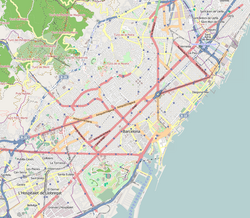
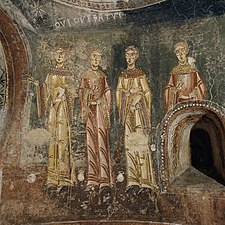





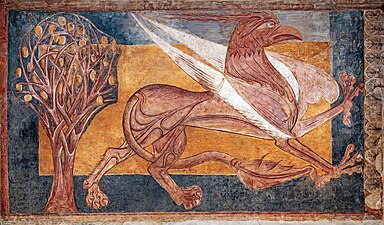




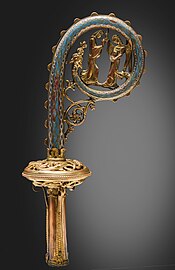




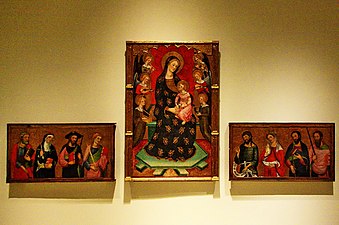


![Jaume Huguet – The Consecration of Saint Augustine[9]](http://upload.wikimedia.org/wikipedia/commons/thumb/7/7f/Jaume_Huguet_-_The_Consecration_of_St_Augustine_-_WGA11794.jpg/206px-Jaume_Huguet_-_The_Consecration_of_St_Augustine_-_WGA11794.jpg)

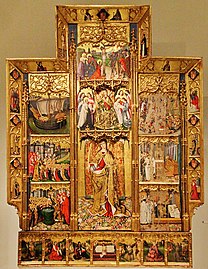
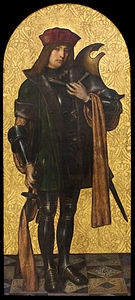





















![Ramon Casas – Ramon Casas and Pere Romeu on a Tandem[11]](http://upload.wikimedia.org/wikipedia/commons/thumb/7/79/Casas_tandem.jpg/343px-Casas_tandem.jpg)





